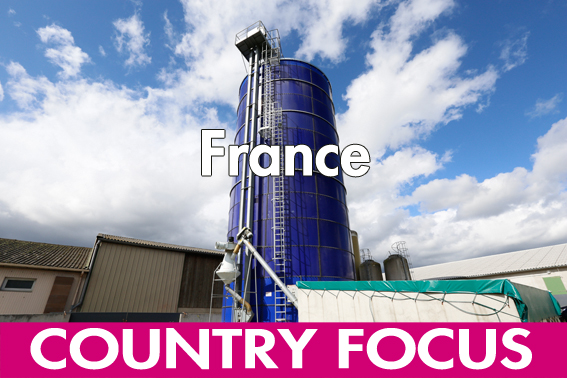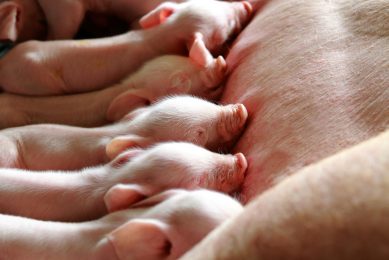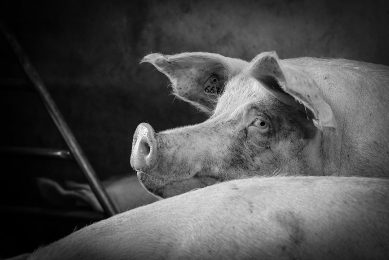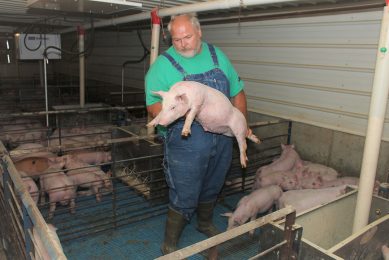French pig industry – investments needed

At the Swine Research Days (JRP) in Paris, February 2016, the economic situation was an important theme, with several speakers highlighting their part of the problem. One conclusion stood out: farmers and slaughterhouses need to invest.
The year 2015 was a difficult year for the French agricultural industry. Images of farmers from all kinds of sectors were blocking major roads in the summer in an attempt to bring attention to their situation. There was a lot to say about their worries – after all the European milk quota had been released and agricultural exports to Russia have been cancelled for geopolitical reasons.
Still, it looks as if the French pig industry has been hit harder than its European counterparts. Despite ever-growing numbers of pigs weaned per sow per year (on average in 2015: 28) and a steadily decreasing feed conversion rate (on average in 2015: 2.8 kg), things are in need of improvement. At the Swine Research Days, France’s pig industry looked into the mirror: what can be improved in pig housing quality and the slaughter industry?
More added value pork products
One complaint that is often heard in France: meatpackers have a monopoly with regard to determining pig prices. Fabien Djaout, representative for France Agrimer, the country’s national institute for agricultural and aquacultural products, highlighted this development against the background of recent fundamental changes in the European slaughtering industry.
In the last decade, the European slaughter industries have undergone considerable changes. The slaughter and processing industry has been subject to fundamental reorganisation with the emergence of major industrial groups operating globally that have invested in the construction of very large slaughterhouses with a high slaughter capacity.
On top of this, products from slaughterhouses have changed significantly as well. European trade has gradually shifted from the sale of carcasses to cuts of meat that are more and more elaborated, as the abattoirs seek greater added value. In addition, customers like meat curers, distributors and caterers increasingly aim to purchase only the parts or cuts of meat they need.
France at a glance
France, one of the founding fathers of the European Union, has traditionally had a strong agricultural business. The vast majority of the country’s pig industry can be found in Brittany, in the country’s far west. The pig industry is organised through many cooperatives, of which Cooperl (slaughtering 6 million pigs/year) is the largest. Pigs are held in relatively small farms. Recent figures do not reveal much to be proud of. Unlike in other European countries, France’s pig numbers have come down substantially in the last years. Figures by the French Pork and Pig Institute (IFIP) show that the number of pigs has come down by 11.4% between 2000-2014. The number of sows even dropped by 28.3%.
This led to a shift in activities. German companies initially benefited due to low labour costs and then were able to invest in the automation of the cutting process. The Danish industry, however, historically specialised in cutting, lost 7,000 jobs between 2003 and 2013 following restructuring, considerable automation of the slaughter chain and from the relocation of secondary cutting activities to Germany. Spain, driven by a very competitive model based on the integration of upstream and downstream sectors, has been able to adapt and develop its exports to Europe.
In this competitive European environment, the French pig sector found itself going through a difficult period, and is now being attacked in its own market by growth of the Spanish, German and Danish imports. In addition, exports face increasing competition in traditional European export destinations like Italy and the United Kingdom, but also in further-away markets like South Korea and Japan.
What should be changed to improve the French situation? Djaout says, “Farmers should create a real marketing vision with solid partnerships with the downstream actors such as slaughterhouses.”
French slaughterhouses need investments to be more automated, with the emphasis put on more added value brought to the cutting units. Djaout adds, “We have to think again about the whole slaughtering chain in order to get more standardised and differenciated pork products.”
Quality of pig housing
A completely different corner of the industry also requires some upgrading, this was made clear by Carole Bertin, a representative of the Regional Chamber of Agriculture in Brittany, France’s most important pig region. She gave an analysis on the pig building status of 30 farrow-to-finish farms in Brittany in 2015. The study was conducted in order to assess their age, technical condition and degree of wear, as well as the consistency of their pig-housing facilities. The evaluation was based on detailed observations of the conditions of building items in all the farms visited.
They found that the average age of buildings was 22.1 years and above 20 years for all physiological stages (mating, gestating sows, farrowing rooms, nursery/post-weaning, finishing). Renovations make it possible to extend the use of buildings, but they are unequal depending on the physiological stage.
Employment in French pig industry
The French pig sector represents 99,000 jobs. A calculation made by Agathe Lang, from the scientific interest group Elevages Demain. She analysed employment directly and indirectly related to French livestock farming. Within the sectors of feed, animal health, genetics, equipment, process industries, distribution as well as the public sector, 135 different operators were considered as dependent on French livestock operations. Of this total, 14,000 are direct jobs located on the 12,600 significantly sized pig farms. The 85,000 remaining jobs are distributed among numerous sectors, of which the majority can be found in the slaughtering, meat processing and distribution business.
For gestating sows (in groups), 72% of places have been renovated whereas 28% were newly built. Housing organisation seems to be consistent for sows, but many farms lack available places for post-weaning and finishing stages. 18 farms had to sell piglets, but the coherence of the building chain was still inadequate, and leads to unfavourable practices which might impact the technical performance, health and economy of farms. The study showed that pig buildings are older than they appeared in a similar study in 2006.
In short, investments are still to be made in order to achieve coherent chain capacities, to renovate and modernise most of the existing Breton pig farms.











